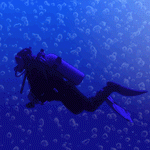There's no particular reason for you to change the settings or raise the max up past 15 since your husband is doing nicely with that range of pressure and he has had quite a battle with leaks before. Glad to hear he's doing better with the mask.DoriC wrote:RestedGal, I know you've explained this before but can you tell me why you advise opening the max to 20, I was told here to keep the spread tighter( I'm on overload so forgot the reason why). We're set at 11-15, titrated at 13, but sometimes his 90% is at 15, so should I change the settings? We've been at these settings from the beginning, haven't changed anything because we were dealing with mask issues. The UMFF seems to be working out better now.
If I were hitting the max pressure sometimes (as he obviously is, or the 90% wouldn't include it) I'd want to raise the max, but that doesn't mean you all should. I also believe in "if it ain't broke, don't fix it."
Ok, about "narrowing the range".... I'm gonna take a deep breath here and copy/paste part of a long email I wrote to someone recently who asked essentially the same thing. Doesn't mean my opinion is right. Everyone's different, so what I happen to think would work fine for most people (not ALL -- there are always exceptions) isn't necessarily so. I'm sure not a doctor or anything in the health care field.
From my email to someone, with some editing for clarity:
Unless a person is having massive leaks that are causing a machine to have to use more and more and more pressure to cope with the leaks, I don't think there's any particular reason for not setting the max at 20. You can see from your own data that the machine is never having to use anything even close to 20 for you. So...it doesn't matter that all that unused ceiling is "up there". It's available but isn't even being used. The "20" up there doesn't affect anything about the operation of the machine in using the pressures it has been using for you.
I think there has been a long time misperception on the message boards about what "narrowing the range" means. Most people who are given an autopap... the machine is prescribed at 4 - 20. It's that minimum pressure of FOUR that causes most people trouble...and causes an autopap (and the bipap auto if "auto bilevel" mode is turned on) to not be able to treat people well. Autopaps (and the bipap auto) can't prevent apneas well with a VERY low minimum pressure. They really need to have the minimum pressure (min EPAP for the BiPAP Auto) set high enough to keep the throat well and truly open during exhaling. A pressure of 4 is just too low to do that for most people.
Because autopaps are designed to raise and lower pressure slowly -- not yo-yo pressure changes up and down abruptly -- the autopap (or bipap auto) set with a minimum very low can run a losing race trying to reach the pressure really needed when sudden, hard apneas hit. Like if a person turns onto his/her back, or goes into REM. Or, worst case scenario, both things together...on your back AND in REM.
So... when people report better success because they "narrowed the range" (they raised the minimum pressure AND dropped the maximum pressure all at the same time), what probably REALLY gave them better results was the fact that they had raised the minimum. Dropping the max likely had nothing to do with it. They were simply dropping the unused max down into yet another area where pressures weren't being used anyway.
For example, say a person posted he was getting an AHI of 8 . And that he was using a range of 4 - 20. And the most pressure his autopap had gone up to was 13 occasionally. He had the software to see that "13" was the most the machine had ever hit with him. Ever. I'd say set the machine at 10 - 20. (No particular reason for my choosing "10"...it just happens to be the pressure that statistics have shown keep the airway open, preventing apneas, for most people.)
If the person set the machine that way -- 10 - 20 (narrowing the range only by raising the minimum pressure) you can bet they'd almost surely get a lower AHI than the AHI they had been getting with the machine set at 4 - 20. And the machine probably still isn't going to go above 13.
Also, if the person set the machine at 10 - 15 ("narrowing the range from both ends") instead of 4 - 20, again you can bet they'd get a lower AHI than the AHI they had been getting. And the machine still probably isn't going to go above 13.
Any which way.... 4 - 20, 10 - 20, or 10 - 15 .... 13 is the most pressure the machine is probably going to use, so it doesn't matter whether there are two cm's of UNused pressure available up above, or 10 cms of UNused pressure available up above. Or 16...or 100.
It doesn't matter whether the max is set at 20 or at 15.... unused pressure up there is simply that...unused. The person wasn't hitting 15 before, nor will he hit 20. So, it doesn't matter if the max is set for 20.
The improvement in AHI most people will see when they "narrow" the range by raising one end and dropping the other end is most likely because of raising that minimum end up to where it could actually do better preventative work. Dropping the max down from one unused pressure to another unused pressure most likely had nothing to do with the improved AHI.
But because so many people "narrowed the range" on both ends at the same time, and saw good results.... BINGO! The idea that the top needs to be lower than 20 keeps getting talked about, when it was that bottom pressure being raised that actually created the better AHI results.
All that said, I'd add this in defense of the idea of "narrowing the range" on both ends. For people who don't have the software and can't get a graphical look at their leak rate, they are flying blind, even if they can see "averages" data in the machine window. Those people that don't have software would be better to set a range about 2 cms below their single prescribed pressure and 2 or 3 cms above it.
That way, if they are having terrible leaks, the machine would be limited in how high it was going to raise the pressure. More pressure and more pressure could just make the leaks worse....like water spurting through a tiny hole in a dam making the hole bigger and bigger...same thing could happen to a mask leak if the machine thinks it's seeing a reduction in YOUR airflow and raises the pressure to try to "treat" that. More pressure might just blow out a wider leaky area. More pressure - bigger leak, and so on, to no avail.
A person who has the software can see if their leaks are controlled decently and are not driving pressure up. That can be hard to "see" on the graph .... can be like "which came first, the chicken or the egg?" If the machine moves to a higher pressure to control events, the leak rate IS going to go up accordingly. The mask's vent rate is supposed to increase as pressure increases. So, it can LOOK like a leak drove it up, when it was really a normal increase in the exhaust vent because of more pressure actually needing to be used to improve the breathing.
Anyway, you don't need to worry about the max of 20. You're never hitting anywhere even near it.
A word about "bad nights". Even if treatment settings are fine, there can be nights that are "worse"...data wise -- or even if the data looks fine, a person can feel lousy the next day. There can be tons of other health issues going on that can cause that. Pain causing micro arousals (disrupting sleep even if not waking a person up) all night can do it, even if a person had a 0 AHI on the data.
There can be soooo many factors interfering with refreshing sleep, even if "cpap" treatment is doing its part of the job like a champ.
There can also be occasional nights of terrible looking data. More often than not, leaks are the culprit, but not always.
Hope your treatment goes smoothly for you on most nights!














